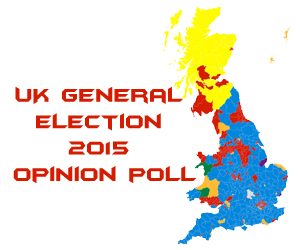Who will win Election 2015? - April 15 Opinion poll, Uk election 2015, general election,YouGov poll for UK polls,Ukip average poll ratings, British Poll
- Details
- Last Updated: Wednesday, 15 April 2015 16:14
Who will win Election 2015? - April 15 Opinion poll
 Labour retain their two point lead over the Conservatives in a YouGov poll for the third consecutive day – but the Tories are still the preferred party at the bookies.
Labour retain their two point lead over the Conservatives in a YouGov poll for the third consecutive day – but the Tories are still the preferred party at the bookies.
This is how the poll looks:
Also Read: UK Election Opinion Poll, UK Opinion poll 2015
|
YouGov/Sun poll - April 15 |
||
|
Party |
Vote % |
Seat Projection |
|
Con |
33% |
261 |
|
Lab |
35% |
307 |
|
Lib Dem |
8% |
14 |
|
UKIP |
13% |
1 |
|
Green |
5% |
1 |
|
SNP |
|
46 |
If this poll is replicated on May 7, the Electoral Calculus seat projector predicts the following results – Labour would be 19 seats short of a majority:
The projection takes into account the latest YouGov poll rating for the parties in Scotland, including the SNP.
It comes on the day that Ukip launches its 2015 election manifesto. The party's poll rating has slipped, starting the year with an average of 17%, now down to just 12.7% – the wrong direction for Nigel Farage's party:
Ukip average poll ratings: January vs April
| Ukip average poll rating | |
| Jan-03 | 17 |
| Apr-13 | 12.7 |
Betting predictions
The opinion polls are not the only measure of who might be running the country after the General Election. The financial markets can also provide a valuable insight into the way voters perceive the parties. This is the latest prediction from Betfair based on the current bets being made by punters:
And their seat forecast is as follows:
|
Betfair Seat Projection - April 15 |
|
|
Political party |
Seats projection |
|
Conservatives |
301 |
|
Labour |
260 |
|
Liberal Democrats |
54 |
|
Ukip |
3 |
|
SNP |
8 |
|
Other |
24 |
Don't forget that in order to win a majority, one of the big parties would need 326 seats. As things stand, the signs are that neither the Conservatives or Labour have enough to govern alone, meaning a deal with one or more smaller parties.
Now take a look at the average of polls from several polling companies – and see how it has changed over time.


